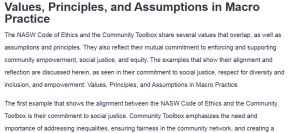Values, Principles, and Assumptions in Macro Practice
The NASW Code of Ethics and the Community Toolbox share several values that overlap, as well as assumptions and principles. They also reflect their mutual commitment to enforcing and supporting community empowerment, social justice, and equity. The examples that show their alignment and reflection are discussed herein, as seen in their commitment to social justice, respect for diversity and inclusion, and empowerment: Values, Principles, and Assumptions in Macro Practice.
The first example that shows the alignment between the NASW Code of Ethics and the Community Toolbox is their commitment to social justice. Community Toolbox emphasizes the need and importance of addressing inequalities, ensuring fairness in the community network, and creating a platform where marginalized voices are heard (Community Tool Box, 2024).
NASW Code of Ethics has social justice as one of its core values and calls social workers to advocate for equal access to opportunities and to challenge oppression (Reisch, 2018).I agree with this alignment since social justice is fundamental and necessary and helps create meaningful change. Social change also addresses the root causes of inequality at both macro and micro levels instead of dealing with symptoms alone.
The second example that shows the alignment between the two is respect for diversity and inclusion. The community toolbox prioritizes inclusivity and competence and catalyzes community-building efforts and respect for diverse backgrounds. The Community Toolbox also prioritizes individuals’ needs, perspectives, and needs (Reisch, 2018).
NASW Code of Ethics explains the significance of social diversity and cultural competence. The code also encourages the social worker to respect the worth and dignity of individuals despite their diverse backgrounds. Looking at this alignment, I resonate with it because the two address systemic challenges that demand an understanding of the unique contextual and cultural factors that affect communities (Community Tool Box, 2024). With this principle in place, practitioners cannot place a one-size-fits-all resolution.
The other example that unveils the alignment between the NASW Code of Ethics and the Community Toolbox is empowerment and capacity building. Community Toolbox hypothesizes that the communities that communities have resources and, above all, have the necessary knowledge they need to solve these challenges (Community Tool Box, 2024).
NASW Code of Ethics explains the essential values of self-determination and advocacy by the social worker to empower people and their communities to make decisions based on information (Reisch, 2018). I agree with the example because empowerment, if done successfully, always results in change. When communities have the necessary tools to take ownership of their solutions, they make meaningful changes. The dynamics also change to collaboration.
In conclusion, the NASW Code of Ethics and Community Toolbox are similar in the empowerment they give to the people, Social Justice, and the foundation of inclusivity. The two also align in that they both guide practitioners in creating sustainable change systematically. As individuals, these shared principles are necessary and essential if communities get effective solutions for their issues. They also ensure that human dignity is upheld and collective action is achieved.
Reference
Community Tool Box (2024) Chapter 1, Section 6 of the Community Toolbox. https://ctb.ku.edu/en/table-of-contents/overview/model-for-community-change-and-improvement/core-principles-and-values/main
Reisch (2018) Macro Social Work Practice: Working for Change in a Multicultural Society. Michael Reisch. San Diego, CA, Cognella Academic Publishing
ORDER A PLAGIARISM-FREE PAPER HERE
We’ll write everything from scratch
Question
Textbook:
- Macro Social Work Practice: Working for Change in a Multicultural Society. Michael Reisch
In your reading in Chapter 1, Section 6 of the Community Toolbox, and in Chapter 1 of the text, there is a discussion on the Community Toolbox’s values, principles, and assumptions, and a discussion on the Code of Ethics values, ethics and principles. How do the Community Toolbox and the NASW Code of Ethic’s align? Please provide at least three examples of this comparing the two perspectives. Do you agree with your chosen examples personally? Why or why not?

Values, Principles, and Assumptions in Macro Practice
Be sure to cite your sources in APA 7.
The Discussion Board should be 275-350 words for the initial response.

